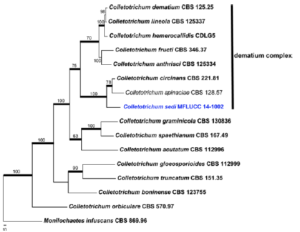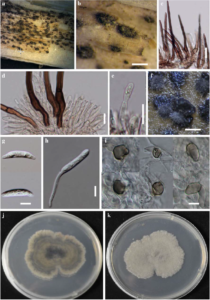Colletotrichum sedi Jayawardena, Bulgakov & K.D. Hyde.
Index Fungorum number: IF550762, Facesoffungi number: FoF00332; Fig. 2
Etymology: Based on the host genus Sedum.
Holotypus: MFLU 14–0623.
Saprobic on dead stalks of Sedum sp. Asexual morph Conidiomata 262–410μm (x=329μm, n=10) diam., solitary, acervulus, black, oval. Setae abundant, 50–125μm long, pale to medium brown, smooth-walled, 1–4-septate, base cylindrical, 2.8–6.8μm diam., apex somewhat acute. Conidiophores simple, to 37 μm long, hyaline, smooth– walled. Conidiogenous cells (7–)10.5–19(–22)×(1–)2.39– 5.2(–6) μm (x=14×3.4μm, n=20), hyaline, smooth–walled, cyllindrical to slighty inflated, opening 1.2–3.7μm diam., Collarette 0.5–1μm long, periclinal thickening visible, Conidia (2–)6.6–10.5(–14)×(1–)2–5(–6)μm (x=7.3×3.6μm, n=40) hyaline, smooth-walled or verruculose, aseptate, curved, both sides gradually tapering towards the round to slightly acute apex and truncate base, guttulate.
On PDA Conidiomata solitary or aggregated, acervulus, submerged, black, circular to oval. Sporulation abundant. Setae 50–120μm long, dark brown up to the tip, opaque, septa difficult to distinguish, 2 to 4-septate, smooth-walled, base cylindrical, straight or±bent, 3–7μm diam., apex acute. Conidiophores to 30 μm long, simple, hyaline. Conidiogenous cells (5–)8.5–16(–19)×(1–)2.5–5(–6)μm (x=12×3.5μm, n=20), hyaline to pale brown, smooth– walled, cyllindrical to slighty inflated, opening 1.2– 3.7μm diam., Collarette 0.5–1 μm long, periclinal thickening visible. Conidia (4–)6–10.3(–14)×(1–)2.3– 5.2(–6)μm (x=6.9×3.6 μm, n=40) hyaline, curved, both sides gradually tapering towards the round to slightly acute apex and truncate base, guttulate. Appressoria (6–)8.5–16.4(–18)×(1–)2.5–4(–5) μm (x=12.5×2.8μm, n=10) solitary to aggregated, in small groups or short chains, medium to dark brown, smooth-walled, round, oval or irregular.
Sexual morph Undetermined.
Culture Characters: Colonies on PDA reaching 45 mm in 7 days at 28 °C, flat with entire margin, olivaceous grey aerial mycelium becoming dull green towards the edge with olivaceous grey to iron grey acervuli from forward, reverse greyolivaceous to dull green, concentric.
Material examined: RUSSIA, Rostov region, Rostov-na- Donu city, Botanical garden of Southern Federal University, flowerbed, on Sedum sp. (Crassulaceae), 5 March 2014, Timur Bulgakov (T94), (MFLU 14–0623, holotype); extype living cultures, MFLUCC 14–1002, CGMCC 3.17570. GenBank ITS: KM974758; GADPH: KM974755; ACT: KM974756; CHS: KM974754; β-tubulin: KM974757.
Notes: The genus Colletotrichum was introduced by Corda (1831) and subsequently treated by Hyde et al. (2009) and Cai et al. (2009). The most recent treatment is by Hyde et al. (2014) which was based on multi-gene phylogeny. The dematium complex contains the type species of the genus,
Colletotrichum lineola (Damm et al. 2009; Cannon et al. 2012). Colletotrichum dematium is mainly characertized by its curved conidia whch is also a character of the species of the truncatum complex but found to occupy distinct separate clades (Damm et al. 2009; Cannon et al. 2012).
Colletotrichum sedi clusters in the subclade comprising C. circinans and C. spinaciae within the dematium complex (Fig. 1). Colletotrichum sedi forms a separate branch with 100 % bootstrap support and 1.00 Bayesian posterior probability. This species differs from C. circinans and C. spinaceae in having longer setae (50–125 μm) with 1–4-septate, simple conidiophores, solitary to aggregated appressoria, in small groups or short chains and smaller conidia (6.6–10.5×2–5 μm).

Fig. 1 Phylogram generated from parsimony analysis based on combined ITS, GADPH, CHS, ACT and β-tubulin sequence data of Colletotrichum. Parsimony bootstrap support values greater than 50 % are indicated above or below the nodes, and branches with Bayesian posterior probabilities greater than 0.95 are given in bold. The ex-types (reference strains) are in bold; the new isolates are in blue. The tree is rooted with Monilochaetes infuscans CBS 869.96.

Fig. 2 Colletotrichum sedi (holotype) a Specimen with conidiomata b Black acervuli c Brown setae d Conidiophores with basal parts of setae e Hyaline conidiogenous cells f Conidiomata on PDA g Hyaline conidia h Germinating conidium i Appressoria j Reverse view of the colony k Upper view of the colony. Scale bars: b=200μm, c=20μm, d=15μm, e, f=10μm, g-i=5μm.
